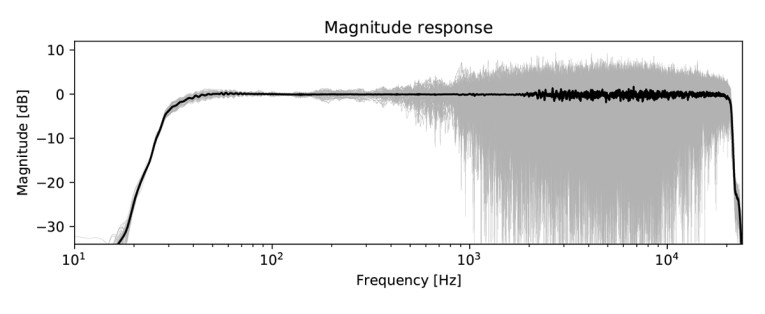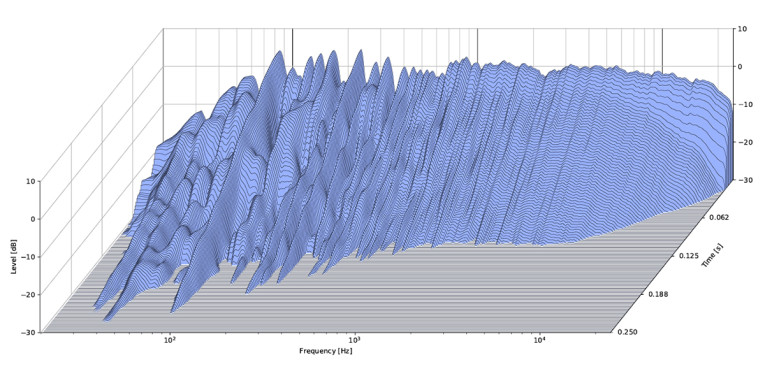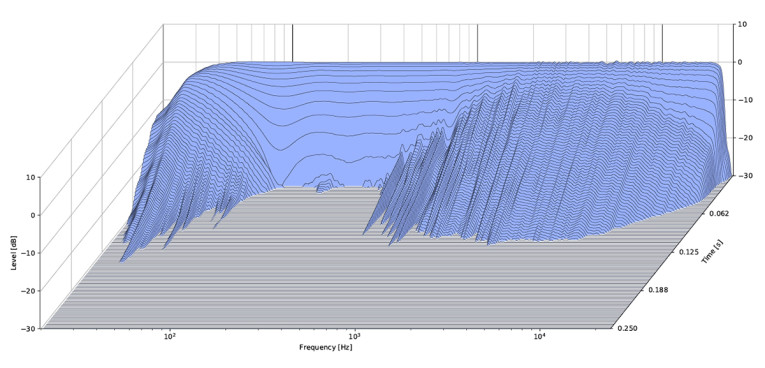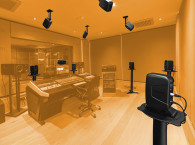This article describes an approach to the challenge of applying DSP room correction to complex multichannel setups, intended for immersive audio reproduction. Instead of one filter applied to a single channel, the author proposes a solution where all speakers work to optimize the reproduction of each input channel.

Over the past 20 years or so, room-correction technology has slowly but steadily made its way into the mainstream of high-quality home audio. Today, many leading audio/video receivers (AVR) come with built-in, DSP-based room-correction solutions. These solutions allow consumers to improve sound system performance in a given space, compensating for a room’s unique characteristics.
Commonly, room-correction systems use a microphone to measure each loudspeaker and generate a filter to correct the speaker/room responses on a per-channel basis. In this way, the time and frequency properties of a channel are optimized independently of other channels in the system.
But home audio is evolving, and room correction must evolve, too. Consumers, content producers, and AVR manufacturers have begun to embrace immersive audio and multichannel formats for all manner of home entertainment, much of which is meant to be enjoyed by multiple people, positioned in multiple locations within a dynamic space. Established methods of room correction may not be sufficient under these circumstances.
With current room-correction systems, a filter can shape a signal in time and frequency, but the spatial response — the way the sound propagates and interacts with objects and room boundaries; the way sound pressure at one position relates to pressure at other positions — remains unaltered. In light of modern, immersive, multichannel home audio experiences, we need room correction to be spatially robust. That is, the system should be able to improve sound performance throughout a spatial distribution of listener positions, rather than at a single point in space. The more complex the room response is (e.g., if the frequency response varies very rapidly with small changes in listener position), the less improvement can be expected from a standard room-correction filter.
In short, a three-dimensional sound field cannot be re-shaped in space through traditional room-correction methods, with one filter applied to a single channel. The solution is loudspeaker co-optimization. All the speakers in an audio system working jointly to reproduce each input channel in an optimal way.

The Possibility of “Spatial“ Room Correction
When we think about it, spatial room correction, which is currently out of reach for single-channel techniques, would be possible if multiple speakers were allowed to cooperate (i.e., if room-correction filters operated simultaneously on several speakers located around a room).
To some extent, this is what happens in a few high-end bass management solutions: Multiple bass-capable speakers, typically subwoofers, can be equalized and phase-shifted with regard to their in-room sum response, thereby reducing seat-to-seat frequency response variations in the common bass channel. Such bass management solutions bring multichannel equalization and phase adjustment to bass speakers.
This is a well-accepted and useful solution, although limited. True spatial room correction applies not only to optimizing a common bass channel, but to all input channels and to a wider range of frequencies.
So, what can we do with multiple channels to stretch a sound system spatially and reach its full potential? A lot, it turns out.
During the 20-plus years of room correction development, the DSP and acoustics research communities have come up with a lot of theories about, and methods for achieving, sound field control. In various ways, such methods are based on multichannel (MIMO) filtering and the physical principles of sound field superposition. However, apart from a few beam-steering and binaural rendering applications (e.g., for soundbars, laptops, PCs, and TV sets), most of this research has yet to be productized for broader consumer markets.
In part, this technology lag is due to system complexity and sensitivity. Combining sound from separate channels certainly creates new possibilities, but it puts higher demand on system reliability and robustness (e.g., manufacturing tolerances and long-term stability of electro-mechanical components). To have the desired effect, the sound fields of loudspeakers, plus room reflections, must add up in exactly the right constructive/destructive way at multiple points in space and at exactly the right time.
Loudspeaker co-optimization and spatial room correction can achieve the right effect. What’s more, through broadband sound field control, users can take control of the full sound wave in time, frequency, and space. They can control not only the way it propagates from the speaker through the room and to the listener, but also its interactions with the room boundaries, enabling all speakers in the system to work jointly to reproduce each input channel in an optimal way.
“Support” Speakers and ”Super” Speakers
As we know, maintaining control over sound quality, channel levels, and room/speaker interaction becomes more difficult the more speakers are added to a system. But with a co-optimization correction scheme, the diversity in a system can actually be exploited and become a benefit rather than a nuisance.
With loudspeaker co-optimization and spatial room correction, each speaker in an immersive, multichannel sound system may simultaneously assume two roles: first, as a primary speaker to be corrected; and second, as a “support” speaker used to correct one or several of the other speakers in the room. Each speaker in the room is helped by all or a subset of the other speakers to reach its target response.
The aim is to get the best possible impulse response from each speaker, taking other available speakers into account as support speakers and creating a virtual “super” speaker. All speakers are used to reproduce each input channel. With a number of speakers placed around the listener, as in typical surround-system layouts, this co-optimization approach allows for the cancellation of reflections and the control of room resonances in ways that are not possible with traditional means.
In practice, co-optimization allows for not only performing impulse response correction of a speaker’s direct sound, but also for enlisting additional speakers that can be used to correct for reflections that would otherwise not be possible. For example, speakers located close to a reflecting surface are better suited than the source speaker to cancel out reflections from that direction.
In the case of stereo, traditionally each input channel is reproduced by one of the front speakers. If each of these front speakers work on their own, the only way to handle room modes is to add or remove power, however, this will only be valid for a very small region of the listening room and the speaker may not be able to handle the increased power. Using multichannel control, additional speakers are used to add and remove power in different positions—and with different timing—simultaneously. This allows, for instance, a more even bass reproduction, with better timing, in larger listening areas.
The Benefits of Loudspeaker Co-Optimization
Loudspeaker co-optimization already exists in the market, although in targeted applications. The Volvo XC90 SUV, for example, has included an audio system that co-optimizes the car’s loudspeakers in frequency, time, and space for optimal bass integration and clarity. The Volvo solution is factory calibrated to recreate the acoustic environments of performance venues. Like in the room solution we’ve discussed, the individual speakers act as one super speaker to create an immersive listening experience for every seat in the automobile.
And as already mentioned, some of today’s bass management solutions offer an early example of co-optimization, although for just one input channel. But true loudspeaker co-optimization can actually improve bass management.
In the MIMO control paradigm, bass-capable speakers (e.g., subwoofers) also contribute optimally to the reproduction of speakers with less bass (i.e., they can extend their frequency range if needed). The system thus performs a sort of implicit bass management, but in this case, the bass content of separate input channels is not re-routed to a single bass channel. It remains intact and is fed to separate (corrected and bass-extended) speakers.
All told, the overall benefits of loudspeaker co-optimization for spatial room correction are notable. For today’s immersive, multichannel content, the sound system enjoys significantly improved correction with control in time, frequency, and space, including a higher degree of control over speaker and room response. The system can achieve a tighter sound; low frequencies are extended; and spatial variations in a room can be minimized (Figures 1–3).



And then there is this benefit: Through loudspeaker co-optimization and spatial room correction, users can shape or design the immersive sound field they desire. Just as a target curve can be used to shape sound to a specific taste in the frequency domain, in multichannel design, it’s possible to shape spatial properties (Figure 4).


Users of a multichannel audio system with a DSP supporting co-optimized, spatial room correction may wonder what room response properties might be interesting to add in order to create a signature sound in a space where they enjoy immersive content. What if a completely anechoic “dry” bass response is not always the most desirable? With new spatial control, users may be able to design other types of sound fields. For example, they could copy the room response of a larger, more comfortable listening space into smaller-sized home cinema.
And because audio systems and the rooms in which they’re enjoyed change over time, the nature of spatial room correction — like today’s traditional room correction — allows for in-room recalibration by the consumer, even as they attempt to shape a room’s spatial properties.
In the end, two inexorable forces in home audio are coming together to form an opportunity seeking a solution: Room correction has established itself as a means for perfecting speaker sound regardless of space and acoustics, at the same time immersive, multichannel audio content is becoming more popular and prevalent. The additional speakers required for immersive audio formats enable a new kind of digital loudspeaker and room correction, one which goes beyond frequency domain and time domain optimization: spatial room correction. aX
This article was originally published in audioXpress, December 2021.
 About the Author
About the AuthorDr. Lars-Johan Brannmark has served for nearly 20 years as an inventor and algorithm designer at Dirac Research AB in Uppsala, Sweden. He is currently Research Fellow and Chief Scientist in the same company, with particular expertise in room correction and sound field control. He holds a Diploma in Sound Engineering from Pite School of Music, Lule University of Technology and he has also studied Electrical Engineering at Purdue University and Musicology at Uppsala University. Before joining Dirac, Lars-Johan worked as a sound engineer at the Swedish National Radio. He holds a PhD in signal processing from Uppsala University.






